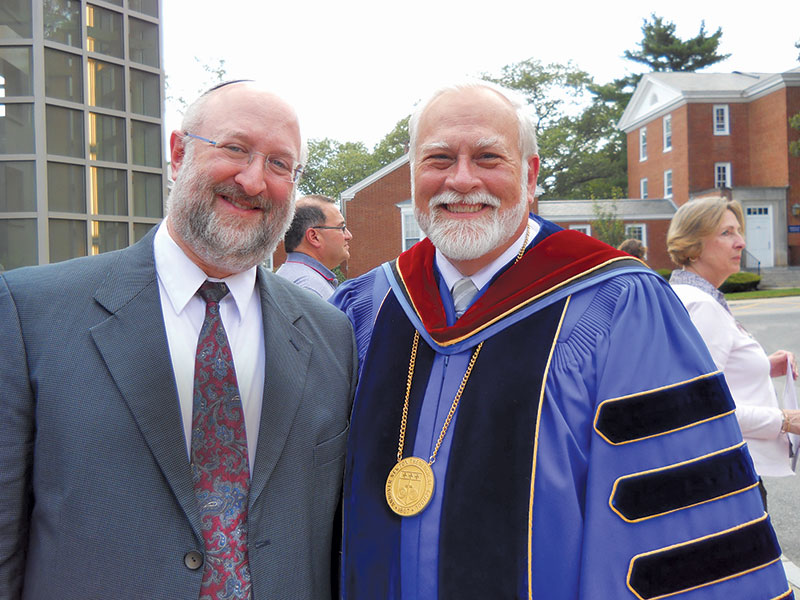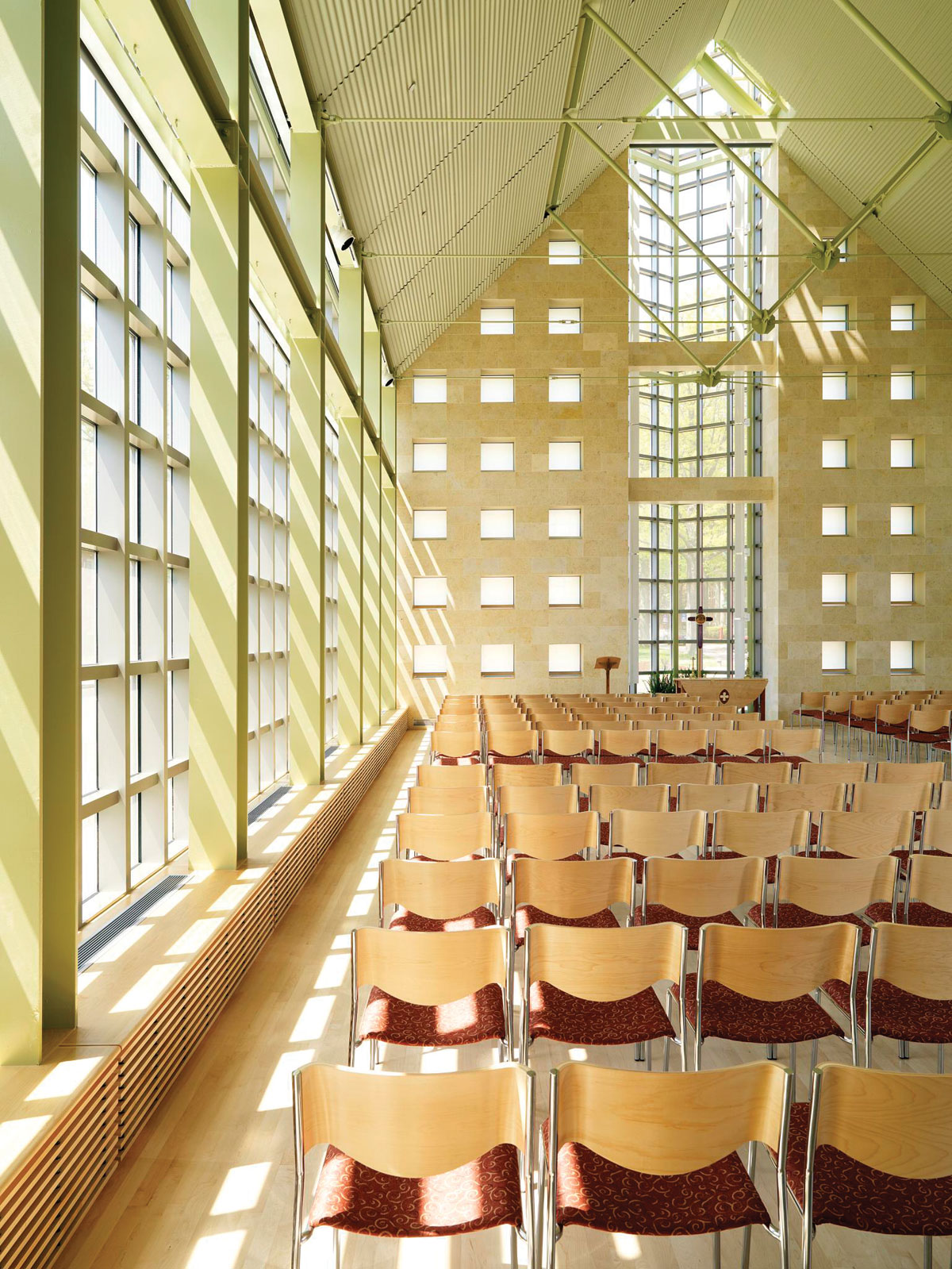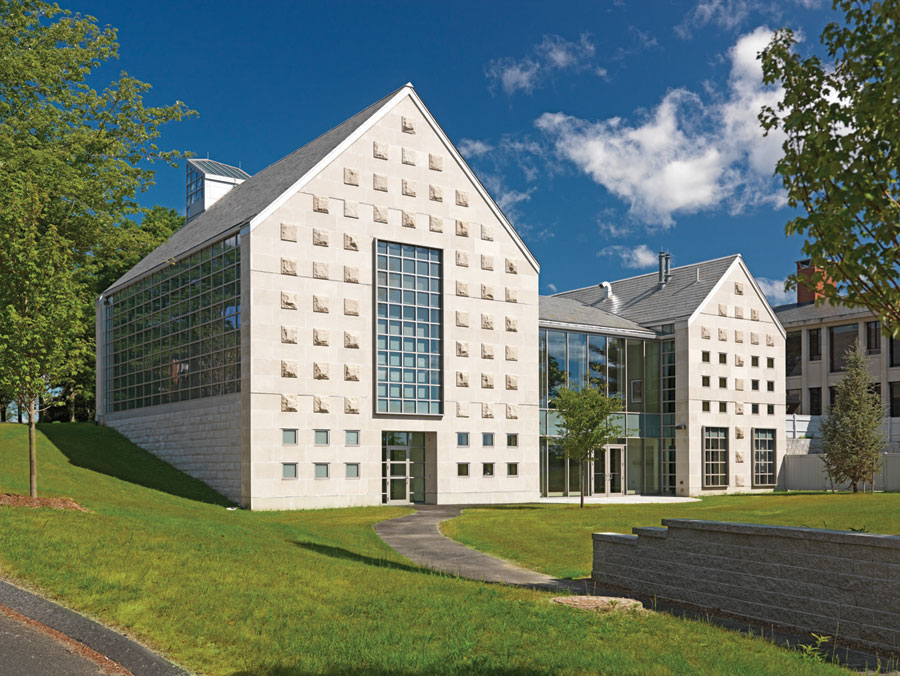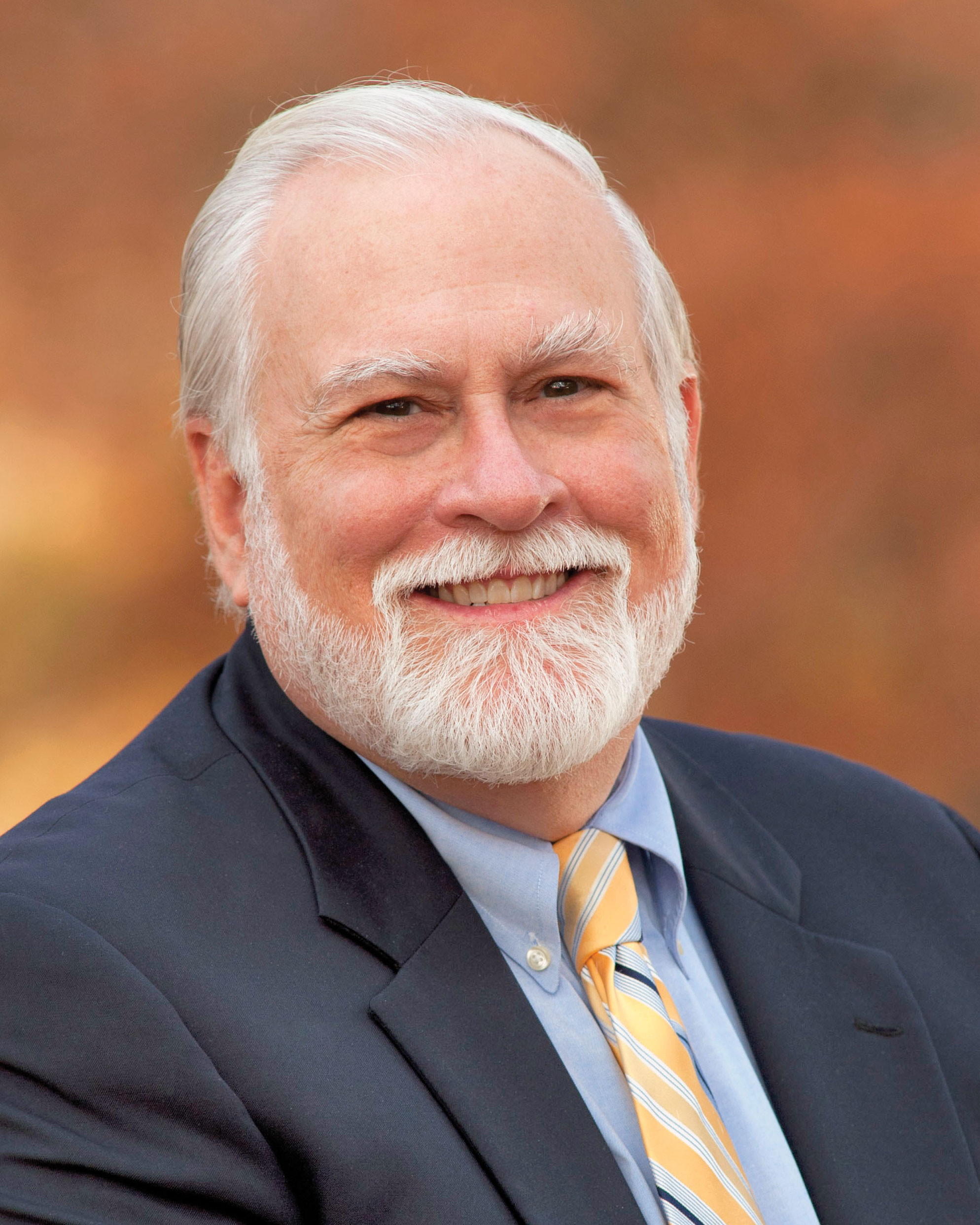 |
Nick Carter (right) meets weekly with Rabbi Daniel Lehmann, the president of nearby Hebrew College, for discussion and study. The two have uploaded a playlist of eight videos on YouTube in which they discuss topics like the Messiah, physician-assisted death, and the Jewish High Holy Days.
Credit: Andover Newton Theological School |
Nick Carter, the first nonacademic to lead the oldest graduate-level theological school in the United States, will retire in June, but his accomplishments are likely to influence the historic campus for generations to come. In his decade as president of Andover Newton Theological School, Carter has expanded the racial and gender diversity of the faculty, inaugurated a competency-based curriculum, positioned the campus as “open and affirming” of the gay and lesbian communities, and supported the founding of the Interreligious Center on Public Life, a joint venture with neighboring Hebrew College.
In Trust recently visited Carter and invited him to reflect on his presidency, share his thoughts on the church he describes as “convulsing with change,” and offer ideas about meeting the needs of students he calls “passionaries.” The following excerpts are highlights of that conversation.
Q. As you contemplate retirement, what advice can you share with new theological school presidents?
First, I’d emphasize the importance of building relationships with other presidents and deans. Brainstorming with colleagues helps a new president avoid a number of pitfalls. We know that so many clergy fail because they isolate themselves intellectually and spiritually.
Second, a new president should see foundation officers and the institution’s own high donors as resources for knowledge as well as givers of money. These people are in a position to broadly recognize the needs of the field. I would remind new presidents that although fundraising is a major part of their job, branding is just as important, because it answers the question of what their schools offer the world. A president who can answer that gets to the heart of why a donor should give money to a school.
Another thing: Be relentless in recruiting and retaining high-quality senior managers — your CFO, academic dean, dean of students and vice president for advancement. This is your team and your power is with them, not over them. The presidency is not a place for insecure people. You have to give your power away by affirming those around you.
When I became president I received some very good advice. I was told to remember that there is no time when you are not the president — even during the most casual moments. Lastly, I heartily endorse the new presidents’ programming offered by the Association of Theological Schools, as well as the association’s other offerings for presidents.
Q. What advice do you wish someone had given you when you took over the presidency?
New presidents need to be counseled that they go to bed with the weight of the entire school on their shoulders. So a president needs to put extra emphasis on self-care — spiritual reflection, exercise, time away, and time with family. The president’s self-care is a model for others. It’s a gift to go to church and be a worshipper rather than the presider!
Something else I learned is that it takes twice as long to get things done. This is especially true in an academic institution because faculty members are reflective and aren’t given to turning on a dime. Another piece of advice I would have appreciated: Plan ahead for crises and the unexpected; have systems with protocols in place before you need them. Also, the president should be a calm presence who helps others to sort through challenges. Presidents need to practice “ego disarmament.” They must have a sober self-perspective and know what they do well and what they don’t do well. It’s important not to take yourself too seriously.
Q. At the risk of generalizing, how do you compare students today with those who were at Andover Newton a decade ago?
Students are more diverse, older, less denominationally convicted, and far more tech savvy. Also, they are increasingly in search of alternative faith careers. I call the younger students “passionaries” — they are looking for ways to save the world and often are turned off by the institutional church and denominations. At the other end of the “passionary” spectrum are the older, second- and third-career students who may have reared their kids and paid off their mortgages but feel unfulfilled and seek more meaning than making money can provide. They’re more interested in pastoral ministry than the younger students — and because student debt is such an issue with younger students, the older ones are in a position to be able to afford to become pastors.
We find our students have a wide range of gifts and abilities. Many are brilliant. Some have a clear call to ministry, and some are seekers, unsure where they’re going. Many do not have the formation in a church that students in other generations have had. Our students come from 30 denominations — a third live on campus, a third commute but stay one or two nights a week, and a third commute every day.
There is no question that theological education is in an adaptive moment. Andover Newton is the oldest graduate theological school in the United States and we like to say that the model for graduate theological education was born here. It’s a model we borrowed from Europe, and the business model was based on denominational support, full-time residential students, and physical classrooms.
All of those assumptions are vanishing. We try to keep our finger on the pulse of church, but when it is convulsing with change, we are forced to revisit our assumptions and ask again what and how we teach and to whom. I would say that schools that limit themselves to merely managing change are at risk; we must think far more boldly and creatively.
 |
Above and below: Andover Newton's Wilson Chapel, completed in 2008, won an award of merit from the American Institute of Architects' Interfaith Forum on Religion, Art and Architecture and Faith & Form magazine. Designed by the architecture firm Donham and Sweeney, the chapel evokes the New England meeting house with its spare design and multiple uses - worship, meetings, cultural events - all of which strengthen the seminary community.
Richard Mandelkorn Photography |
Q. And that leads to the topic of curriculum. What are the changes and the underlying rationales?
Every school assumes a certain model of “church” that guides the curriculum. In many cases it has not been evaluated for 50 years or more, and yet it drives how we decide what courses we teach and how we teach them. At Andover Newton, with our commitment to pastoral ministry and because of the radical changes we are facing, we have had to revisit our assumptions and ask again, “How effective are we?” As a result, we have changed from a discipline-based curriculum to a competency-based curriculum that moves us to a more student-centered approach.
We now ask, “What are they learning?” not “What are we teaching?” And then we can more accurately assess what we do. We have not abandoned Bible and theology, but we now define them differently by asking, “What are the skills and knowledge needed for a new generation?” The new normal is constant change. St. Paul and Luther have essential insights, but they didn’t anticipate Twitter!
An example of something we are figuring out is what we call the development of “border-crossing skills” — how we live and work with people who don’t look like us, think like us or worship like us. The hard and increasingly violent realities of religious difference in the world beg the question, “Where will the world turn for hope?” When we realize that religious leaders must be the sources of that hope, we realize how much more they need to be prepared for the 21st century than the 20th or 19th centuries.
This requires a far deeper commitment than merely getting to know the “other” or nurturing a mindset of tolerance. We have discovered in our decade-long relationship with Hebrew College that there is great value in building a level of trust that enables us to take on our differences and learn how to navigate these critical borders knowledgeably and respectfully. We have joint classes, joint faculty meetings, and even joint faculty retreats.
In a remarkable development, Hebrew College and Andover Newton have adjusted their curricula. They offer a course in Christianity and we offer a course in Judaism. And as presidents, Rabbi Daniel Lehmann and I have our own curriculum — we study Bible together, meeting once a week in a havruta format, which means two friends sitting down to interpret a text together. We even have a podcast — just go to http://bit.ly/therevandtherav.
Q. I can tell that these efforts are important to you on many levels. What prompts this?
My faith is deeply important. And I’m a pacifist. I want to live my life in such a way that situations like terrorism and wars are less likely to happen. Jesus was remarkable in how He crossed countless borders and engaged those whom others rejected. For him, preaching and doing were the same thing. I want to try to live like that. I believe that an authentic faith mandates our embrace of the “other” no matter how complicated that may be.
Q. How does a theological school president relate to denominational judicatories today? Are there special challenges or special joys?
Denominations are moving more and more away from the seminaries — stopping or reducing funding is just one way. And there is the important question of what percentage of the student body actually belongs to a denomination. As I mentioned, our students represent 30 denominations. Most seminaries like the idea of their traditional denominational identity, but the reality is that there is not much support in those associations anymore. Some seminaries’ bylaws still say there must be a fixed percentage of denomination members on their board and faculty, but schools are increasingly finding these requirements to be constrictive and unreflective of new realities.
Also, many judicatories have programs that compete with the seminaries. The M.Div. used to be the gold standard for ministry, but there are now alternate paths to ministry. Our core assumptions are being swept away.
Just think about contemporary congregational membership. More than half of the members in today’s congregations didn’t grow up in that denomination, so ministers cannot make assumptions about their knowledge of, or allegiance to, a particular denomination. The number one reason that people join a church now is for the sense of community they find there.
So we must ask: “Where do ministers learn how to build community?” It isn’t in the seminary classroom. Rather, it is the “hidden curriculum” outside the classroom. In order to begin to address this challenge, we have begun a twice-a-year program we call Community Day. We cancel classes and take on campus-wide projects that involve students, staff, and faculty. So you might find a student and the registrar and a professor planting trees together. In the spring, Hebrew College joins us — a wonderful opportunity for building an interfaith community.

Q. What have you learned about shared governance as you have worked with your board during your presidency?
One learns immediately that there is need for role clarity, and that has to be part of the president’s orientation as well as part of the board’s orientation. All participants in shared governance need to know and accept the boundaries. All need to recognize their roles and their responsibilities.
The board needs to be intentional about how it shares governance with the faculty. There is no place for micromanagement with faculty or with administration. And yet the board has to understand that ultimately they have responsibilities they cannot delegate. All need to look at how flexible and agile the governance structures are — especially the bylaws. It’s important not to be trapped in a straitjacket in changing times and to always remember that things like Robert’s Rules are just tools.
Q. Many of our readers are board members or board chairs. What can you tell them about optimizing their relationship with their theological school president?
Something I found really valuable is the covenant that I was able to create with my board chair. This “leadership covenant“ recognizes that our positions have unique perspectives and roles, but they share a common responsibility to model servant leadership, practice good communication, and enable the work of others. It covers our focus on the mission of Andover Newton, the sustenance of our faith lives, our respect and support for one another, the need for a high level of communication while respecting the need for confidentiality, and our efforts to have fun and relax together. We have a commitment to assessment including presidential evaluation by the board and regular board self-evaluation. We have candid conversations with each board member about their level of financial support.
Q. What do boards need to do to strengthen their effectiveness in governance?
Boards must recognize they are the keepers of the mission. In fact, I’d say this is their greatest “trust.” Periodic assessment of the school’s progress in achieving its mission is vitally important. The president and the board need to recognize that in this regard they are engaged in a unique partnership of leadership. There is need to find ways for the board to be generative and not always taken up with reports. The board must be engaged and needs to know what challenges and issues the president is wrestling with.
Q. And how do boards strengthen their effectiveness vis-à-vis the faculty?
Board members and presidents must ask, “How can we help faculty be better teachers and scholars?” Most important in this regard is the relationship of the president and the dean. The dean is the doorway to the faculty, and the president and board must value her and empower her to do her work. Sometimes presidents see faculty as a problem to be solved instead of taking delight in them — a president, and the board, should find a way to love faculty members, even in those times when they don’t seem so loveable!
Read the Andover Newton leadership covenant here.
=============
A road less traveled
 |
| Credit: Len Rubenstein |
Nick Carter’s path to the presidency of Andover Newton Theological School is unusual. After graduating from Colgate Rochester Crozer Divinity School, Carter founded a ministry for young adults in Rochester, New York, served on the American Baptist denominational staff in New York City, and pastored the First Baptist Church in Beverly, Massachusetts. He left ministry “reluctantly” to become executive director of SANE/FREEZE, a grassroots peace and justice organization.
In 1985 he led a delegation to the first Reagan-Gorbachev summit in Geneva. His work to halt nuclear weapons testing earned him the Dahlberg Peace Award, which is given by the American Baptist Churches.
In 1996, a belief that many types of organizations can be effective agents of change prompted Carter to accept the position of vice president of public affairs and strategy for Imagitas Inc., a marketing communications company with the mission to build partnerships that leverage private sector resources for public sector services. The company was awarded Vice President
Al Gore’s “Hammer Award” in 1999 for saving the U.S. Postal Service more than $50 million a year.
Carter later founded Wayfinders Consulting, a firm offering counsel to religious, educational, and other nonprofits in strategic planning, communications, conflict resolution, and fundraising. Andover Newton recruited Carter from Wayfinders in 2004.